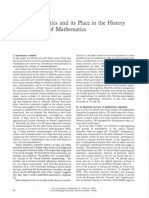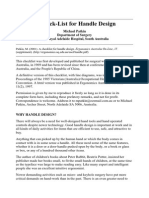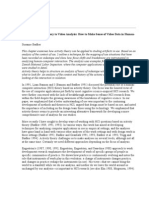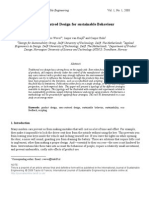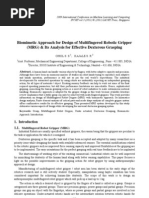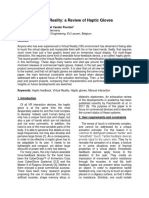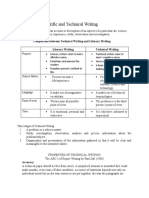0 ratings0% found this document useful (0 votes)
20 viewsAssignment 3 PDF
The document summarizes an assignment about analyzing the affordances of pliers. It describes the basic lever mechanism of pliers, which allows users to apply greater force with less effort. It then discusses Gibson's theory of affordances and how the affordances of an object depend on both its intrinsic properties and the user's goals and abilities. For pliers, affordances include grasping, cutting, gripping, and other actions enabled by the fulcrum and jaws. The conceptual model of pliers is also discussed, along with possible redesigns to improve usability.
Uploaded by
NAGESH AGRAWALCopyright
© © All Rights Reserved
Available Formats
Download as PDF, TXT or read online on Scribd
0 ratings0% found this document useful (0 votes)
20 viewsAssignment 3 PDF
The document summarizes an assignment about analyzing the affordances of pliers. It describes the basic lever mechanism of pliers, which allows users to apply greater force with less effort. It then discusses Gibson's theory of affordances and how the affordances of an object depend on both its intrinsic properties and the user's goals and abilities. For pliers, affordances include grasping, cutting, gripping, and other actions enabled by the fulcrum and jaws. The conceptual model of pliers is also discussed, along with possible redesigns to improve usability.
Uploaded by
NAGESH AGRAWALCopyright
© © All Rights Reserved
Available Formats
Download as PDF, TXT or read online on Scribd
You are on page 1/ 3
Assignment 3
By Nagesh Agrawal 19bdi022
Object Chosen: Plier
The main reason on choosing this object is the fact that it has a
basic mechanism called ‘levers’ which made such a huge impact
to our world that it becomes one of the most common tools in
the history. The plier generally consists of a pair of metal levers
coupled at a fulcrum positioned closer to one end of the levers,
creating small jaws on one side of the fulcrum and longer
handles on the other side. This design creates a mechanical
advantage allowing the force of the user hand's grasp to be
magnified and focused on an object with precision. The plier's
jaws can also be used to manipulate objects too small or
unwieldy to be handled with the fingers.
Affordability & Conceptual Model
A tool is a device that can be used to construct an object or
execute a task, but which is not consumed in the process.
While in use, a tool is a kind of extension of the hand,
basically, an attachment to it or even a part of the user's own
body, and hence is no longer a part of the environment of the
user. But if it is not in use, the tool is simply a disconnected
object of the environment, graspable and portable, to be
certain, but nevertheless external to the observer.
Affordance
“According to Gibson’s (1979) theory, it is the affordances,
described as opportunities for action that are directly offered
by the intrinsic perceptual properties of objects, that allow us
to use tools. Since these properties are invariant, the
affordances do not change as a function of our needs and
goals. They are directly perceived without any need to call on
previous experiences with the tool and knowledge of its
function. This view of affordances was modified by authors
who pointed out that they are relations between one’s abilities
and features of the environmental situation (Tucker and Ellis,
2001; Chemero, 2003) and that they depend on previous
experience and the current goal (Rosenbaum et al., 1990).
Given this view, the perception of affordances depends on
one’s needs in the specific situation at hand as well as on the
ultimate aim of the action. For example, the affordance of a
knife lies in the ability to cut food at lunchtime even though it
may also be used to retighten the screw of one’s spectacles if
needed.”
(From article - https://doi.org/10.3389/fpsyg.2017.01073)
The affordance of the object: As mentioned above- the
affordance of the plier varies between functional and
situational aspects. Here, the perceptual properties of
objects can be identified by their looks, weight and material.
A user may perceive grasping affordance as the fulcrum that
will help them to recognize the handles and jaws of the plier.
Also, the jaws of the object can be perceived for cutting,
gripping, compressing, pulling, bending, twisting affordance.
These affordances were based on looks and functional
aspects.
A user may perceive it for hammering and anvilling
affordance because of its materialistic aesthetics. Where a
user also perceives the object for its weight affordance.
These affordances are based on the situational aspect.
In all these cases, the previous experience and knowledge
may not be a factor here. And hence the functional
perceptual properties remain invariant but because of an aim
or goals of the user, they may discover different affordance
of the object as well.
Conceptual Model:
A ‘mental model’ describes a user’s fundamental
expectations about how something should work which is
constantly evolving and subject to change. A conceptual
model is a part of a mental model created by the designers as
a high-level plan for how the product will work and fit
together. It is made up of different elements and ultimately
represents the interface that the user interacts with. The
conceptual model includes for the chosen object are the
elements like architecture similar to lever having jaw and
handle based products such as scissors, pincer, etc. making
the interface common for all similar designs.
Story About the Product
Since the mechanical characteristic of this object is so simple
that can be learned without doing any study and thus,
making it a historical tool. I guess the inventor of this tool find
difficulty on hold things that may be hot, tiny, toxic material
or harmful and hence invented the plier for the world, back
then maybe the material of this product was different and
weak comparative to today’s plier material but till that time
they were much aware of the leverage mechanism and how
they can take benefit from it. For them maybe the frippery
was not their priority and made the tool for single
functionality but since then this product start evolving till the
current stage.
The Possible New Redesigns:
The possible redesigns that can improve the perceivability of
the product are:
1. Introduce the semi-hard rubber grip over the handle
allowing the user better grip thus improving the
perceivability of the product.
2. Redesign the jaws into a better combination of
teethes and cutter avoiding the wrong affordance of
the product.
3. Introduce Add-on handles to improve the strength of
the jaw for better holding affordance perceiving.
4. Introduce clamps to lock the position of the jaws in
place so that the user's hands get free.
You might also like
- D'Ambrosio, U. (1985) - Ethnomathematics and Its Place in The History and Pedagogy of Mathematics. For The Learning of Mathematics, 5 (1), 44-48100% (1)D'Ambrosio, U. (1985) - Ethnomathematics and Its Place in The History and Pedagogy of Mathematics. For The Learning of Mathematics, 5 (1), 44-485 pages
- The Application of The Concept of Affordance To A Creative Design MethodNo ratings yetThe Application of The Concept of Affordance To A Creative Design Method10 pages
- Design and Analysis of A Soft Finger End Effector For Industrial PurposeNo ratings yetDesign and Analysis of A Soft Finger End Effector For Industrial Purpose8 pages
- Achieving Inclusion With Contextualized User-Sensitive DesignNo ratings yetAchieving Inclusion With Contextualized User-Sensitive Design20 pages
- Revise and New Paper For Research 12 AUTO 1 Group 2 UpdatedNo ratings yetRevise and New Paper For Research 12 AUTO 1 Group 2 Updated34 pages
- Hand Out Home Based Learners G8 Electronics WEEK 1No ratings yetHand Out Home Based Learners G8 Electronics WEEK 15 pages
- User-Centered Design: 1. Introduction and HistoryNo ratings yetUser-Centered Design: 1. Introduction and History6 pages
- Multi-Segmented Finger Design of An Experimental Prosthetic HandNo ratings yetMulti-Segmented Finger Design of An Experimental Prosthetic Hand9 pages
- Development and Assessment of A Hand Assist DeviceNo ratings yetDevelopment and Assessment of A Hand Assist Device15 pages
- aukes-et-al-2014-design-and-testing-of-a-selectively-compliant-underactuated-handNo ratings yetaukes-et-al-2014-design-and-testing-of-a-selectively-compliant-underactuated-hand15 pages
- Universal Robotic Gripper: (Based On Jamming of Granular Materials)0% (1)Universal Robotic Gripper: (Based On Jamming of Granular Materials)23 pages
- Assisting Designers in The Anticipation of Future Product UseNo ratings yetAssisting Designers in The Anticipation of Future Product Use16 pages
- CAP 07 - Applying Activity Theory To Video Analysis - How To Make Sense of Video Data in Human - Computer InteractionNo ratings yetCAP 07 - Applying Activity Theory To Video Analysis - How To Make Sense of Video Data in Human - Computer Interaction17 pages
- User-Centred Design For Sustainable BehaviourNo ratings yetUser-Centred Design For Sustainable Behaviour16 pages
- Designing An Affordable Prosthetic Arm CompressedNo ratings yetDesigning An Affordable Prosthetic Arm Compressed7 pages
- Comprehensive Design Guidelines for Product RelationshipsNo ratings yetComprehensive Design Guidelines for Product Relationships6 pages
- Week 1: Class Introduction: Chapter 1: What Is Interaction Design? ANDNo ratings yetWeek 1: Class Introduction: Chapter 1: What Is Interaction Design? AND4 pages
- Shantilal Shah Engineering College BhavnagarNo ratings yetShantilal Shah Engineering College Bhavnagar18 pages
- Parameters Affecting Interaction With Gestures in Ubiquitous EnvironmentsNo ratings yetParameters Affecting Interaction With Gestures in Ubiquitous Environments11 pages
- A Tool Is Any Physical Item That Can Be Used To Achieve A GoalNo ratings yetA Tool Is Any Physical Item That Can Be Used To Achieve A Goal4 pages
- Copia de Teoria Protesis Mano Bionica 1 - InglésNo ratings yetCopia de Teoria Protesis Mano Bionica 1 - Inglés9 pages
- Paper Review Haptic Gloves Actuator 2018 FinalNo ratings yetPaper Review Haptic Gloves Actuator 2018 Final6 pages
- Four Ways of (Mis-) Conceiving Embodiment in Tool UseNo ratings yetFour Ways of (Mis-) Conceiving Embodiment in Tool Use27 pages
- Toolbox Simple Tools Stone Tools Hundreds of Millennia Equipment ForkNo ratings yetToolbox Simple Tools Stone Tools Hundreds of Millennia Equipment Fork5 pages
- Cs 3724: Mental Models and Conceptual Design: Dr. Scott Mccrickard Mccricks@Cs - Vt.EduNo ratings yetCs 3724: Mental Models and Conceptual Design: Dr. Scott Mccrickard Mccricks@Cs - Vt.Edu36 pages
- Design & Development of Multipurpose, Space Saving Seating Arrangements Using ErgonomicsNo ratings yetDesign & Development of Multipurpose, Space Saving Seating Arrangements Using Ergonomics6 pages
- Unifying User Stories, Use Cases, Story Maps: The power of verbsFrom EverandUnifying User Stories, Use Cases, Story Maps: The power of verbsNo ratings yet
- General History of Africa, Abridged Edition, V.1 Methodology and African PrehistoryNo ratings yetGeneral History of Africa, Abridged Edition, V.1 Methodology and African Prehistory367 pages
- Mahatma Gandhi Kashi Vidyapith: Objectives, ImportanceNo ratings yetMahatma Gandhi Kashi Vidyapith: Objectives, Importance15 pages
- Validity and Reliability in Qualitative ResearchNo ratings yetValidity and Reliability in Qualitative Research3 pages
- Importance of Strategies in Knowledge Management.No ratings yetImportance of Strategies in Knowledge Management.5 pages
- Understanding Culture, Society, and Politics-Module 5 (Q1 Wk10)100% (2)Understanding Culture, Society, and Politics-Module 5 (Q1 Wk10)15 pages
- Free Labor: Workfare and The Contested Language of Neoliberalism, by John KrinskyNo ratings yetFree Labor: Workfare and The Contested Language of Neoliberalism, by John Krinsky3 pages
- PP1 Schemes of Work Language ActivitiesNo ratings yetPP1 Schemes of Work Language Activities18 pages
- 29856-Article Text-115861-2-10-20230615No ratings yet29856-Article Text-115861-2-10-2023061511 pages

